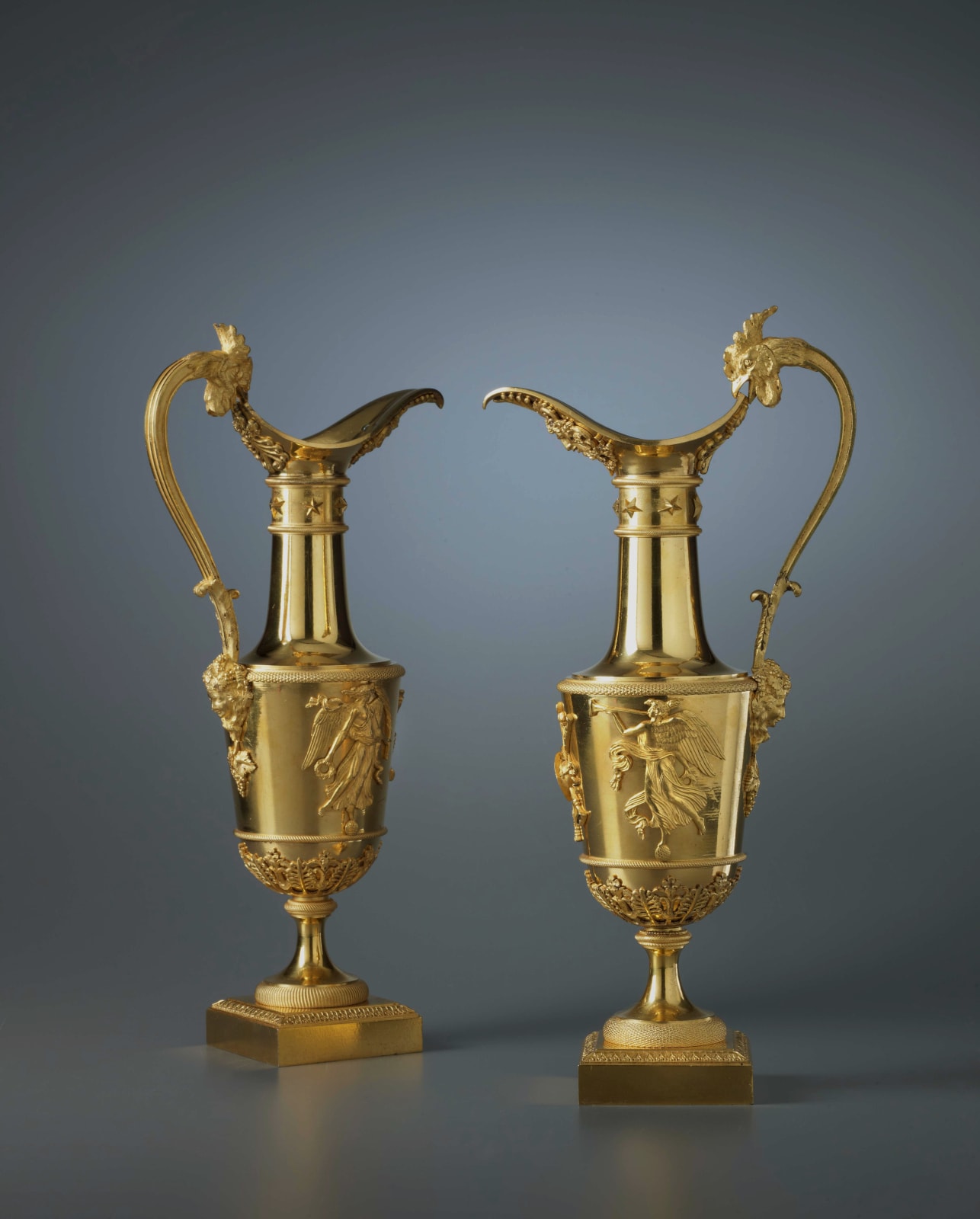Claude Galle (attributed to)
A magnificent pair of Empire gilt bronze ewers attributed to Claude Galle, both with elongated necks mounted at the top with stars and on the underside of the spout by a grotesque male head with grape and vine leaf beard surmounted by an anthemion, with scrolled handles terminated at the top by the head of a cockerel gripping the rim of the ewer in its beak and mounted at the base of the handle by the head of a beautiful bacchante with a headdress of grapes and vine leaves gathered under her chin from which hang a bunch of grapes, the body of the ewer mounted with two winged female figures in diaphanous robes who stand on a sphere, with one playing a pipe and the other holding a palm frond in one hand and a wreath in another, the two figures centred by a ribbon-hung musical trophy, one of which incorporates pan pipes, a flute and recorder and the other castanets, flute and possibly a shawm, the body on a spreading circular foot on a square stepped base with foliate banding
Paris, date circa 1810
Height 39.5 cm. each.
The outstanding quality, finesse and unusual design of these ewers is such that they can be attributed to the celebrated fondeur-ciseleur Claude Galle (1759-1815) who was one of the foremost bronziers of the late Louis XVI and Empire periods. Galle created several pairs of related gilt or gilt and patinated bronze ewers which can be admired in the collections at La Malmaison, Pavlovsk Palace, St. Petersburg, the Ostankino Palace, Moscow as well as the Württembergisches Landesmuseum in Stuttgart. As here they are of similar extravagant form and in particular have female mask heads at the base of the handles; many have a maiden at the top, which like the cockerel here clasps the rim of the ewer and finally they have a similar grotesque or foliate head on the underside of the spout. Claude Galle also created a number of other ewers as well as urns, vases and clock cases of similar inventiveness featuring figural handles and elaborate decorative mounts (see for instance Hans Ottomeyer and Peter Pröschel, “Vergoldete Bronzen”, 1986, p. 364-65). Among them is a covered vase mounted with maenads similar to the present female figural mounts that dance with the same abandon (illustrated ibid, p. 364, pl. 5.12.9).
Received as a maitre in 1786, Galle gained many commissions from the Garde-Meuble de la Couronne and then enjoyed significant patronage under Napoleon. He is known to have collaborated with Pierre-Philippe Thomire (1751-1843) and was responsible for the majority of bronzes d’ameublement supplied during the Empire to Château de Fontainebleau. He also supplied numerous bronze furnishings and fittings for the palaces at Saint-Cloud, the Trianons, Tuileries, Compiègne, Rambouillet as well as a number of Italian palaces including Monte Cavallo, Rome and Stupinigi near Turin. Today his work can be found among the world’s finest collections which include the Musée National de Château de Malmaison, the Musée Marmottan in Paris, the Museo de Reloges at Jerez de la Frontera, the Residenz Munich and the Victoria and Albert Museum in London.
Since these ewers were intended to hold wine, their decorations allude to Bacchus the mythological god of wine. Therefore there are bacchante heads with vine leaves and grapes at the base of the handles and likewise grotesque heads with vine leaves and grape clusters at the underside of the spout; they also feature an array of musical instruments that may have been played by maenads or bacchantes at festivals to celebrate the grape harvests, however it is unlikely that the female figures dancing and playing a pipe around the body of the ewer are maenads since they are winged. On the other hand the cockerel, which is sometimes portrayed as a symbol of Lust came to be associated sensual gratification and the personification of Luxury and thus by association with bacchic revelry.
